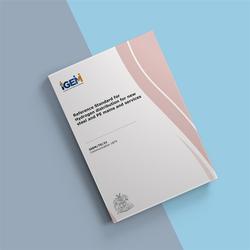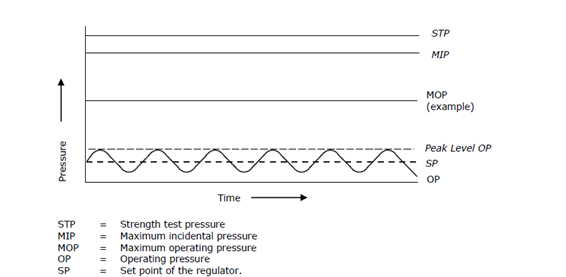IGEM/TD/21 - Reference Standard for Hydrogen distribution for new steel and PE mains and services

This Reference Standard addresses the issues arising from the proposal to distribute
Hydrogen through steel and polyethylene (PE) pipelines (mains and services) at pressures below 7 bar. Where the term pipeline is used, it applies to both mains and services; specific requirements for mains and services will be specified as mains or services.
This Reference Standard addresses Hydrogen services and service pipework. For the purposes of this Standard, the term “service” is used throughout for all requirements and is not limited to “service pipework”.
This Reference Standard covers new Hydrogen mains and services operating at MOP not exceeding 7 bar for:
- polyethylene (PE100) between 0ºC and 40ºC
- polyethylene (PE80) between -20ºC and 40ºC
- steel between -25ºC and 40ºC
This Reference Standard covers Hydrogen distribution for use in domestic and small commercial premises up to the supplier’s emergency control valve (ECV).
This Reference Standard is developed in the first instance to consider domestic and smaller commercial gas infrastructure. Additional safety measures and precautions which will need to be determined by risk assessment may be required for gas supply to more complex users such as:
- educational establishments
- multi-occupancy buildings
- non-standard distribution networks (networks which supply gas to commercial and domestic premises where there are sections of above and below-ground pipework in accessible areas such as shopping centres etc.)
- non-standards services to caravans, residential parks, and moored boats
Introduction
1.1 This Reference Standard has been agreed between the IGEM Technical Co ordinating, Gas Transmission and Distribution, and Hydrogen Committees, who are responsible for the publication of IGEM Standards and has been approved by IGEM’s Technical Co-ordinating Committee on behalf of the Council of IGEM.
1.2 This Reference Standard aims to identify and discuss the principles required for the design, construction, inspection, testing, operation and maintenance of new hydrogen pipelines for use with Hydrogen distribution at pressures equal to or below 7 bar.
This document intends to:
- provide a point of reference for those requiring an understanding of the implications of distribution Hydrogen at pressures below 7 bar
- detail the characteristics of Hydrogen
- detail the comparisons between Hydrogen and Natural Gas (NG)
- identify the measures which should be considered when designing, operating and maintaining mains and services to be used in a trial for Hydrogen distribution at operating pressures below 7 bar.
This Standard is intended to be a source of reference for any subsequent Hydrogen trials and any related IGEM documents.
1.3 Within this document, reference is made to both NG and methane. The composition of NG is predominately methane, however, for theoretical testing purposes, tests are carried out using 100% methane (G20). There are no significant difference in combustion characteristics between the two gases.
1.4 This Reference Standard makes use of the term “must”, “shall” and “should” when prescribing particular requirements:
- the term “must” identifies a requirement by law in Great Britain (GB) at the time of publication
- the term “shall” prescribes a requirement which, it is intended, will be complied with in full and without deviation
- the term “should” prescribes a requirement which, it is intended, will be complied with unless, after prior consideration, deviation is considered to be acceptable.
Such a term may have different meanings when used in legislation, or Health and Safety Executive (HSE) Approved Codes of Practice (ACoPs) or guidance, and reference needs to be made to such statutory legislation or official guidance for information on legal obligations.
1.5 It is now widely accepted that the majority of accidents in industry generally are in some measure attributable to human as well as technical factors. People who initiated actions that caused or contributed to accidents might have acted in a more appropriate manner to prevent them.
To assist in the control of risk and proper management of these human factors, due regard is to be taken of HSG48 and HSG65.
1.6 The primary responsibility for compliance with legal duties rests with the employer. The fact that certain employees, for example “responsible engineers”, are allowed to exercise their professional judgement does not allow employers to abrogate their primary responsibilities. Employers are required to:
(a) have done everything to ensure, so far as is reasonably practicable, that there are no better protective measures that can be taken other than relying on the exercise of professional judgement by “responsible engineers”.
(b) have done everything to ensure, so far as is reasonably practicable, that “responsible engineers” have the skills, training, experience and personal qualities necessary for the proper exercise of professional judgement.
(c) have systems and procedures in place to ensure that the exercise of professional judgement by “responsible engineers” is subject to appropriate monitoring and review.
(d) not require “responsible engineers” to undertake tasks which would necessitate the exercise of professional judgement that is not within their competence. There are to be written procedures defining the extent to which “responsible engineers” can exercise their professional judgement. When “responsible engineers” are asked to undertake tasks which deviate from this they are to refer the matter for higher review.
1.7 Materials and the techniques of construction and operation are constantly being improved and it is intended to keep this Standard under review.
1.8 Requests for interpretation of this Standard in relation to matters within their scope, but not precisely covered by the current text, are to be either:
- addressed to Technical Services, IGEM, IGEM House, 26 & 28 High Street, Kegworth, Derbyshire, DE74 2DA; or
- emailed to [email protected].
1.9 IGEM has adopted the terms and definitions used in European standards for pressure i.e. maximum operating pressure (MOP), operating pressure (OP), maximum incidental pressure (MIP) and strength test pressure (STP). Figure 1 explains these terms. Further guidance can be found in IGEM/TD/13.

FIGURE 1 – PRESSURE TERMINOLOGY
1.10 This Standard was published in August 2023.
Scope
2.1 This Reference Standard addresses the issues arising from the proposal to distribute Hydrogen through steel and polyethylene (PE) pipelines (mains and services) at pressures below 7 bar. Where the term pipeline is used, it applies to both mains and services; specific requirements for mains and services will be specified as mains or services.
This Reference Standard addresses Hydrogen services and service pipework. For the purposes of this Standard, the term “service” is used throughout for all requirements and is not limited to “service pipework”.
2.2 This Reference Standard covers new Hydrogen mains and services operating at MOP not exceeding 7 bar for:
- polyethylene (PE100) between 0ºC and 40ºC
- polyethylene (PE80) between -20ºC and 40ºC
- steel between -25ºC and 40ºC
Note 1: This Standard does not specifically cover the construction of mains and services of other materials. Engineers may consider alternatives brought about by advances in technology and proven concepts (see clause 1.6).
Note 2: Steel pipelines for Hydrogen transmission at MOP of > 7 bar are covered in Hydrogen Supplement to IGEM/TD/1.
Note 3: For the repurposing of existing natural gas distribution network refer to IGEM/TD/22 Reference Standard for Repurposing Natural Gas Distribution Mains and Services for Hydrogen.
2.3 Hydrogen as referred to in this document, is as per the specification set out in Appendix 3, and therefore does not cover blends of Hydrogen and NG.
2.4 This Reference Standard covers Hydrogen distribution for use in domestic and small commercial premises up to the supplier’s emergency control valve (ECV).
2.5 This Reference Standard is developed in the first instance to consider domestic and smaller commercial gas infrastructure. Additional safety measures and precautions which will need to be determined by risk assessment may be required for gas supply to more complex users such as:
- educational establishments
- multi-occupancy buildings
- non-standard distribution networks (networks which supply gas to commercial and domestic premises where there are sections of above and below-ground pipework in accessible areas such as shopping centres etc.)
- non-standards services to caravans, residential parks, and moored boats.
2.6 Pressures quoted are gauge pressures unless otherwise stated.
2.7 Italicised text is informative and does not represent formal requirements.
2.8 Appendices are informative and do not represent formal requirements unless specifically referenced in the main sections via the prescriptive terms “shall” or “should”.
